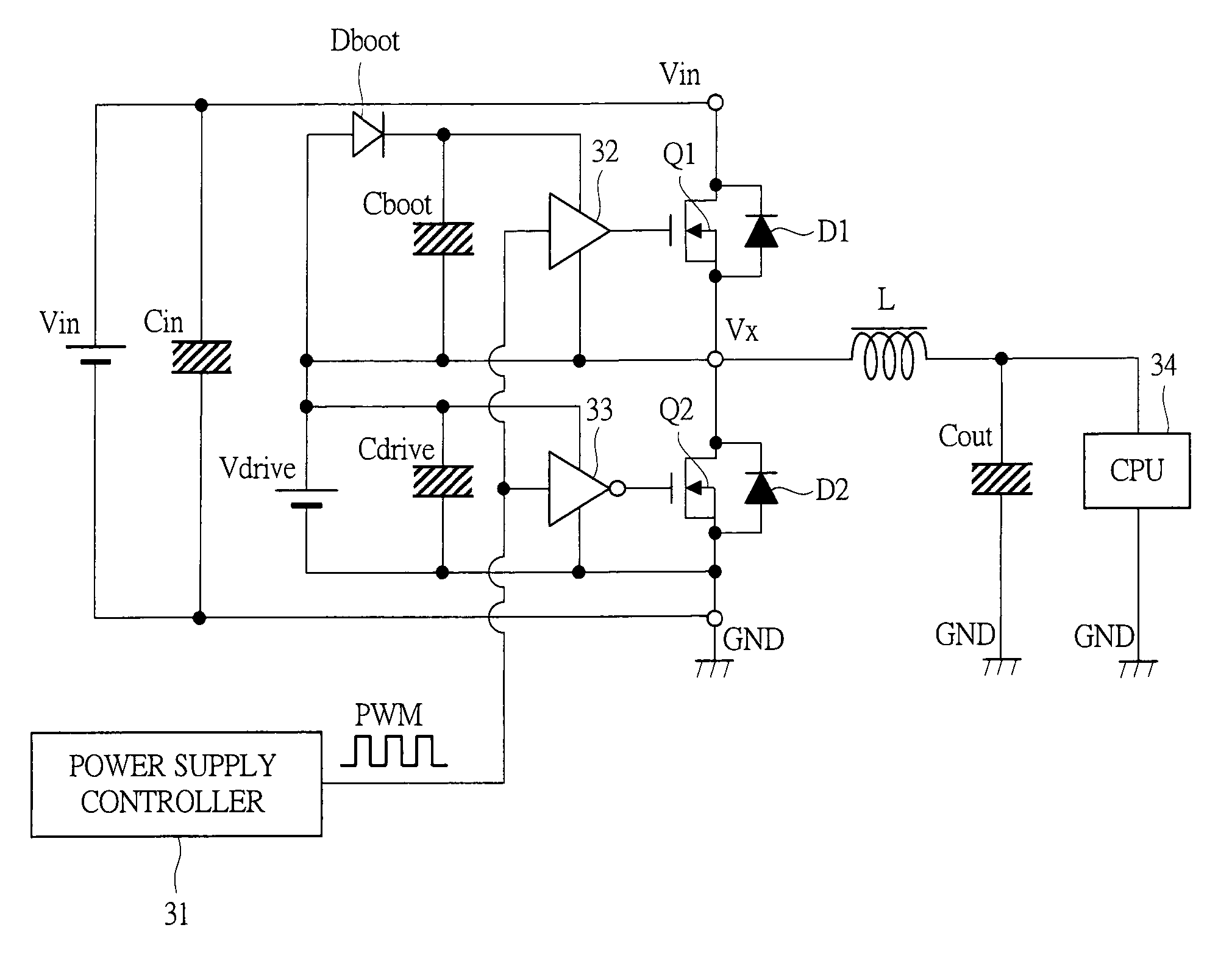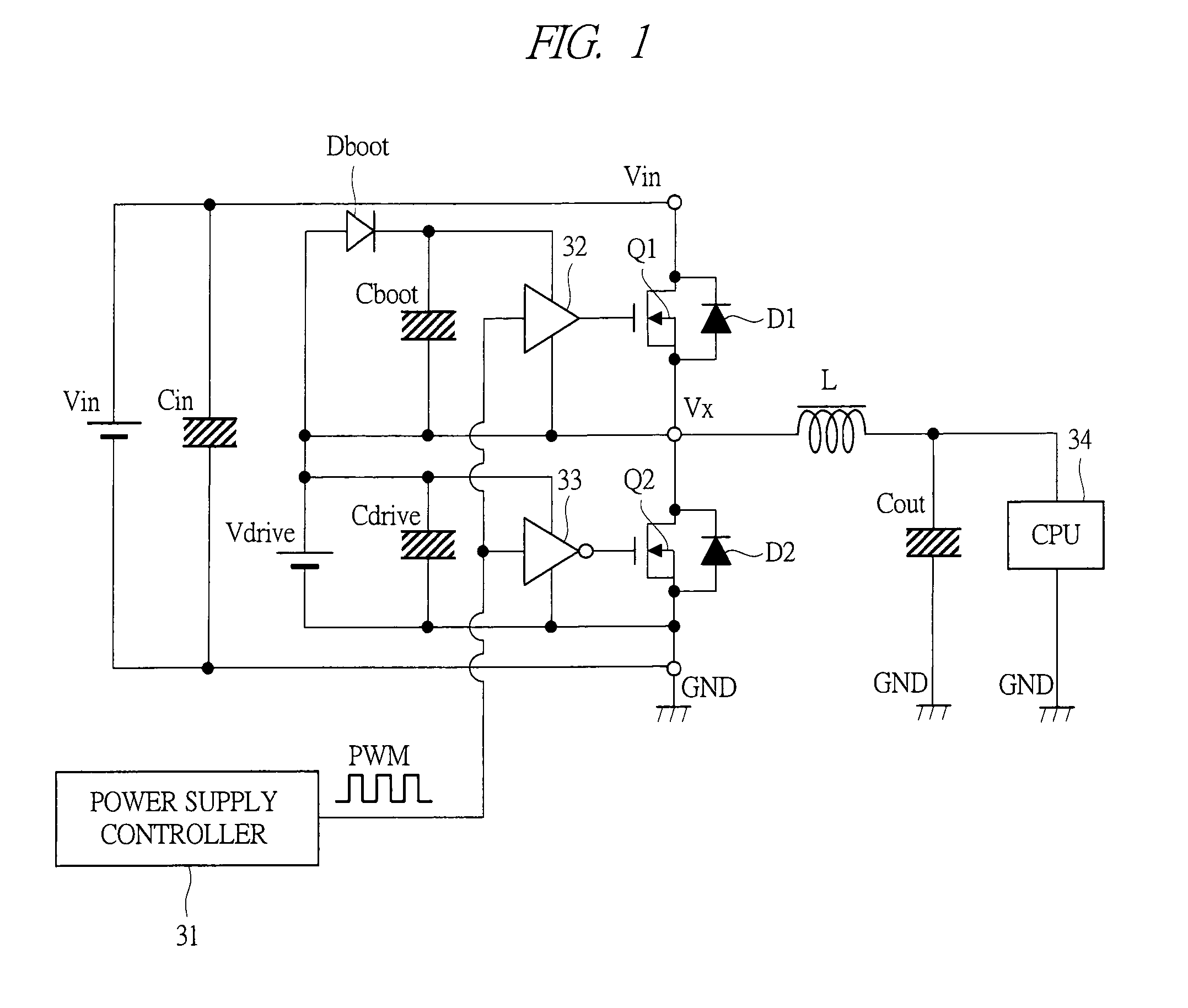Semiconductor device
- Summary
- Abstract
- Description
- Claims
- Application Information
AI Technical Summary
Benefits of technology
Problems solved by technology
Method used
Image
Examples
first embodiment
[0028]First, a semiconductor device according to a first embodiment of the present invention will be described with reference to FIG. 2. FIG. 2 is a layout view showing the semiconductor device according to the present embodiment. FIG. 2 is an illustration viewing the semiconductor device from a connecting portion side.
[0029]The semiconductor device according to the present embodiment is applied to a non-isolated DC-DC converter as shown in FIG. 1 described above. That is, the semiconductor device of the non-isolated DC-DC converter includes a high-side switch Q1, a high-side driver 32, a low-side switch Q2, and a low-side driver 33. The high-side switch Q1 is configured with a lateral MOSFET whose drain is connected to an input power supply Vin and whose source is connected to an output inductor L. The high-side driver 32 is a driver for driving the high-side switch Q1 and is connected to a gate of the lateral MOSFET of the high-side switch Q1. The low-side switch Q2 is configured ...
second embodiment
[0046]FIG. 9 is a layout view showing a semiconductor device according to a second embodiment of the present invention.
[0047]A different point of the semiconductor device according to the present embodiment from that of the first embodiment is that not only the high-side driver 4a and the low-side driver 4b arranged in the regions closer to the periphery of the semiconductor substrate 1 but also a high-side driver 4c and a low-side driver 4d arranged in a region closer to the center of the semiconductor substrate 1 are provided as the drivers for the high-side switch 2 and the low-side switch 3. By arranging the drivers in the periphery region and the center region in this manner, distances from the high-side drivers 4a and 4c to the high-side switch 2 become short and distances from the low-side drivers 4b and 4d to the low-side switch 3 become short, so that further improvement of the conversion efficiency can be expected compared to the first embodiment.
[0048]For example, in FIG....
third embodiment
[0051]When switches and drivers for driving the switches are mounted on the same semiconductor substrate like in the above-described first and second embodiments, a semiconductor device used as the switches is a lateral MOSFET. In the lateral MOSFET, the source region and the drain region are formed on a surface of the semiconductor substrate, and the source electrode and the drain electrode are also formed on the surface of the semiconductor substrate (one example of the lateral MOSFET is disclosed in Patent Document 1). The lateral MOSFET can have a large current capacity per unit area of the semiconductor substrate when breakdown voltage is low, but it is required to lengthen a distance between the source and the drain in the lateral direction when breakdown voltage is high, and therefore, the current capacity becomes small.
[0052]Compared to this, in a vertical MOSFET, a region for maintaining the voltage between the source and the drain is arranged in the vertical direction of t...
PUM
 Login to View More
Login to View More Abstract
Description
Claims
Application Information
 Login to View More
Login to View More - R&D
- Intellectual Property
- Life Sciences
- Materials
- Tech Scout
- Unparalleled Data Quality
- Higher Quality Content
- 60% Fewer Hallucinations
Browse by: Latest US Patents, China's latest patents, Technical Efficacy Thesaurus, Application Domain, Technology Topic, Popular Technical Reports.
© 2025 PatSnap. All rights reserved.Legal|Privacy policy|Modern Slavery Act Transparency Statement|Sitemap|About US| Contact US: help@patsnap.com



